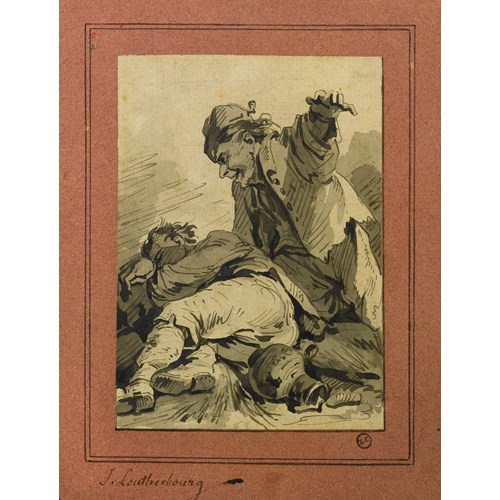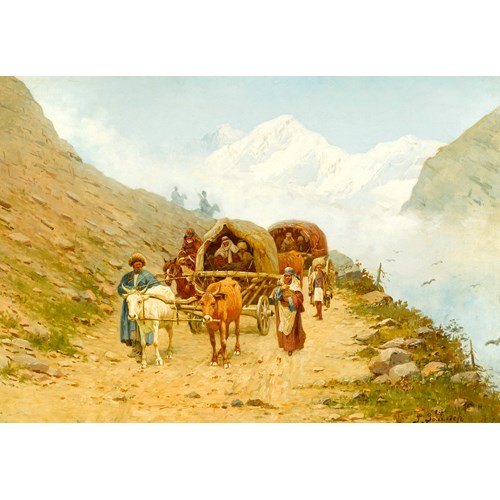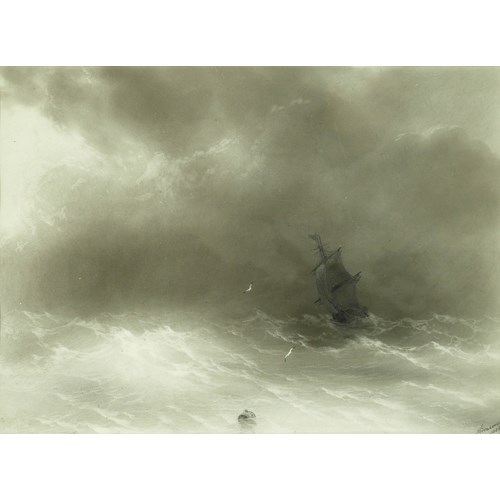Marketplace
An Artist’s Studio & A Nobleman’s Picture Gallery
Balthasar van den Bossche
An Artist’s Studio & A Nobleman’s Picture Gallery
Epoque 1600-1750, 17th century, 18th century
Origine Belgium
Medium Oil on canvas
Dimension 89.5 x 76.4 cm (35¹/₄ x 30¹/₈ inches)
Pictures of artists in their studios flourished as never before in the seventeenth-century Dutch Republic. Balthasar van den Bossche’s An Artist’s Studio and A Nobleman’s Picture Gallery are examples of this popular subject. The first painting deals with the artist within his environment, the other demonstrates the fine taste and collection of a nobleman’s gallery. Many of the same painters who turned to representing the familiar world naturalistically; in landscapes, genre scenes and portraits, also depicted the painter’s studio as a scene from daily life. For painters, these images of the schilderkamer, or ‘painter’s room’, the mundane Dutch term for studio, were a means to both conceptualise and advertise their art. For collectors and art lovers, the studio scene fed a growing fascination with the creative artist, which was also evident in the vogue for self-portraits and biographies of painters. The numerous pictorial representations of artists’ studios and picture galleries provide information on artistic practice and theory in the Netherlands during the seventeenth-century.
Martin writes of the inventories accompanying the studios of Jan Vermeer (1632-1675), Rembrandt van Rijn (1606-1669), and Gerard Dou (1613-1675); they held a large amount of stock for their works, depending on the nature of their pictures (Rembrandt’s inventory included a shield, a statue for draping fabric, costumes and jewellery).¹ One can see van den Bossche’s use of the same props in An Artist’s Studio and A Nobleman’s Picture Gallery, for instance, the heavy drape and globe appear in both paintings, and can be seen again in a work painted by van den Bossche on the same subject, held by the Hermitage. Also within the Hermitage collection is another treatment of a related subject, this time a depiction of a sculptor’s studio. The props in the latter work are less luxurious, and the space does not parallel the nobleman’s gallery in the same way that the artist’s studio does, indeed the sculptor’s studio appears to be more of a rough workshop. Nevertheless classical references are still used; globes and statues, references to classical figures and the worldly wealth and knowledge of the educated Dutch, are often found within depictions of an artist’s studio from this period. To the left of the composition beyond a column is a window revealing a leafy Italian view, this was included by van den Bossche in every work. The positioning of light in these two pictures is seen in many of the works created by van den Bossche’s contemporaries such as Vermeer. Martin writes that the light for seventeenth-century artist studio portraits always comes from the north, from side windows rather than roof panels.
Many Antwerp artists in the period from 1550 to 1570 created paintings which were self-referential in context: ‘art about art’. William van Haecht’s (1593-1637) Cabinet of Cornelis van der Geest stands for the heyday of the genre. Works which express the urge for self-affirmation were also to be found in Italy. The role of artists had changed significantly around the turn of the seventeenth century and artists associated themselves with nobility and assumed a key role in society. Richly furnished studios or rooms with varied types of paintings, classical statues and books tell us about the intellectual aspirations of the artist or nobleman depicted. There was a buoyant economy which stimulated the collecting of art. Around this time the art lover, the forerunner of the connoisseur, made his appearance; this can be called the ‘socialisation’ of art. Artists depicted themselves, or had themselves depicted, with attributes denoting wealth, learning, and interest in music and sculpture. The second half of the seventeenth century saw the rise of connoisseurship in the modern sense of the word. Here, van den Bossche’s nobleman is shown surrounded by objects which infer his intellect and knowledge of art. Around him, attendant figures hang on his every word as he apparently holds forth. He is cast as the typical Dutch connoisseur. The fact that his objects and poise do not differ from those of the artist, shown in van den Bossche’s An Artist’s Studio, communicates the artist’s belief in his role as intellectual within society, on a par with noblemen.
The Dutch studio scene drew on and transformed pictorial tradition. Since the fifteenth century, pictures of artists had served as vehicles for painters to convey their ideas about their art and practice. In the earliest representations, painters appeared in elevated historical guises, either as the Evangelist Luke painting his miraculous vision of Mary and the Infant Jesus, or as famous painters from antiquity such as Apelles, painter to Alexander the Great. In general, as an aspect of the Renaissance elevation of painting to a liberal art, the pictorial rendering of an artist’s studio was invariably an art-theoretical allegory.
Dutch painters, with Rembrandt at the fore, overthrew the previous two centuries’ notions of the studio, rejecting historical guises and idealised settings for an astonishing range of seemingly direct, true-to-life images of the painter at work. Rembrandt’s shabby, humble studio, in which the painter confronts his painting alone, heralded the psychological intensity of his portraits and history paintings. Adriaen van Ostade (1610-1685), who specialised in scenes of peasant life, created the most dilapidated studio image of all, as if the painter of peasants must be a peasant himself. Gerrit Dou (1613-1675), Rembrandt’s pupil, refined the pointedly ordinary studio by injecting erudite allegories of the arts. Jan Steen (1626-1679) advertised his comic bent by poking fun at allegorical pretensions and rendering the ideal love of art as earthly desire. Vermeer represented the studio as an elegant domestic interior, much like the settings of his genre pictures. Despite their authentic look, Dutch studio scenes are more about imagining and promotion than giving the viewer a priviliged behind the scenes tour.
Van den Bossche studied under the Flemish genre painter Gerard Thomas (1663-1720) and was very much influenced by his teacher’s genre style of interior painting. In particular this can be noted in his depictions of well furnished bourgeois rooms and conversation pieces, the detailed settings that helped to display his patrons’ gentility; symbols of politesse, artistic sentiment and representation of fashion and wealth, which showed they possessed all the necessary material as well as social graces. Van den Bossche established a reputation for just such works, and was fascinated by the presentation of studio interiors and collectors’ galleries, with figures emblematic of the arts, as exemplified by the present pictures. These works did vary a great deal within the genre, as illustrated by a comparison between the present pair and the sparser, exterior setting of the Hermitage’s Visit to a Sculptor. Descamps recorded in 1763 that the figures in his paintings were more elegant than those of Thomas.
Van den Bossche was accepted into the Antwerp Guild in 1697 before travelling to France where he had a studio for some time in Paris, returning to Antwerp in 1700. There he worked for an art dealer, and continued to paint with notable success, receiving patronage from important figures such as the Duke of Marlborough in Antwerp (1650-1722), after the Battle of Ramillies in 1706. In 1774 Sir Joshua Reynolds (1723-1792) referred to van den Bossche when writing about the French painter, Antoine Coypel (1661-1722): ‘the modern affectation of grace in his works, as well as in those of van den Bosch (sic.) and Watteau, may be said to be separated by a very thin partition from the more simple and pure grace of Correggio and Parmegiano’.
¹ Martin, W., The Burlington Magazine for Conoisseur, Vol. 81, no. 31 (Oct. 05).
Martin writes of the inventories accompanying the studios of Jan Vermeer (1632-1675), Rembrandt van Rijn (1606-1669), and Gerard Dou (1613-1675); they held a large amount of stock for their works, depending on the nature of their pictures (Rembrandt’s inventory included a shield, a statue for draping fabric, costumes and jewellery).¹ One can see van den Bossche’s use of the same props in An Artist’s Studio and A Nobleman’s Picture Gallery, for instance, the heavy drape and globe appear in both paintings, and can be seen again in a work painted by van den Bossche on the same subject, held by the Hermitage. Also within the Hermitage collection is another treatment of a related subject, this time a depiction of a sculptor’s studio. The props in the latter work are less luxurious, and the space does not parallel the nobleman’s gallery in the same way that the artist’s studio does, indeed the sculptor’s studio appears to be more of a rough workshop. Nevertheless classical references are still used; globes and statues, references to classical figures and the worldly wealth and knowledge of the educated Dutch, are often found within depictions of an artist’s studio from this period. To the left of the composition beyond a column is a window revealing a leafy Italian view, this was included by van den Bossche in every work. The positioning of light in these two pictures is seen in many of the works created by van den Bossche’s contemporaries such as Vermeer. Martin writes that the light for seventeenth-century artist studio portraits always comes from the north, from side windows rather than roof panels.
Many Antwerp artists in the period from 1550 to 1570 created paintings which were self-referential in context: ‘art about art’. William van Haecht’s (1593-1637) Cabinet of Cornelis van der Geest stands for the heyday of the genre. Works which express the urge for self-affirmation were also to be found in Italy. The role of artists had changed significantly around the turn of the seventeenth century and artists associated themselves with nobility and assumed a key role in society. Richly furnished studios or rooms with varied types of paintings, classical statues and books tell us about the intellectual aspirations of the artist or nobleman depicted. There was a buoyant economy which stimulated the collecting of art. Around this time the art lover, the forerunner of the connoisseur, made his appearance; this can be called the ‘socialisation’ of art. Artists depicted themselves, or had themselves depicted, with attributes denoting wealth, learning, and interest in music and sculpture. The second half of the seventeenth century saw the rise of connoisseurship in the modern sense of the word. Here, van den Bossche’s nobleman is shown surrounded by objects which infer his intellect and knowledge of art. Around him, attendant figures hang on his every word as he apparently holds forth. He is cast as the typical Dutch connoisseur. The fact that his objects and poise do not differ from those of the artist, shown in van den Bossche’s An Artist’s Studio, communicates the artist’s belief in his role as intellectual within society, on a par with noblemen.
The Dutch studio scene drew on and transformed pictorial tradition. Since the fifteenth century, pictures of artists had served as vehicles for painters to convey their ideas about their art and practice. In the earliest representations, painters appeared in elevated historical guises, either as the Evangelist Luke painting his miraculous vision of Mary and the Infant Jesus, or as famous painters from antiquity such as Apelles, painter to Alexander the Great. In general, as an aspect of the Renaissance elevation of painting to a liberal art, the pictorial rendering of an artist’s studio was invariably an art-theoretical allegory.
Dutch painters, with Rembrandt at the fore, overthrew the previous two centuries’ notions of the studio, rejecting historical guises and idealised settings for an astonishing range of seemingly direct, true-to-life images of the painter at work. Rembrandt’s shabby, humble studio, in which the painter confronts his painting alone, heralded the psychological intensity of his portraits and history paintings. Adriaen van Ostade (1610-1685), who specialised in scenes of peasant life, created the most dilapidated studio image of all, as if the painter of peasants must be a peasant himself. Gerrit Dou (1613-1675), Rembrandt’s pupil, refined the pointedly ordinary studio by injecting erudite allegories of the arts. Jan Steen (1626-1679) advertised his comic bent by poking fun at allegorical pretensions and rendering the ideal love of art as earthly desire. Vermeer represented the studio as an elegant domestic interior, much like the settings of his genre pictures. Despite their authentic look, Dutch studio scenes are more about imagining and promotion than giving the viewer a priviliged behind the scenes tour.
Van den Bossche studied under the Flemish genre painter Gerard Thomas (1663-1720) and was very much influenced by his teacher’s genre style of interior painting. In particular this can be noted in his depictions of well furnished bourgeois rooms and conversation pieces, the detailed settings that helped to display his patrons’ gentility; symbols of politesse, artistic sentiment and representation of fashion and wealth, which showed they possessed all the necessary material as well as social graces. Van den Bossche established a reputation for just such works, and was fascinated by the presentation of studio interiors and collectors’ galleries, with figures emblematic of the arts, as exemplified by the present pictures. These works did vary a great deal within the genre, as illustrated by a comparison between the present pair and the sparser, exterior setting of the Hermitage’s Visit to a Sculptor. Descamps recorded in 1763 that the figures in his paintings were more elegant than those of Thomas.
Van den Bossche was accepted into the Antwerp Guild in 1697 before travelling to France where he had a studio for some time in Paris, returning to Antwerp in 1700. There he worked for an art dealer, and continued to paint with notable success, receiving patronage from important figures such as the Duke of Marlborough in Antwerp (1650-1722), after the Battle of Ramillies in 1706. In 1774 Sir Joshua Reynolds (1723-1792) referred to van den Bossche when writing about the French painter, Antoine Coypel (1661-1722): ‘the modern affectation of grace in his works, as well as in those of van den Bosch (sic.) and Watteau, may be said to be separated by a very thin partition from the more simple and pure grace of Correggio and Parmegiano’.
¹ Martin, W., The Burlington Magazine for Conoisseur, Vol. 81, no. 31 (Oct. 05).
Epoque: 1600-1750, 17th century, 18th century
Origine: Belgium
Medium: Oil on canvas
Dimension: 89.5 x 76.4 cm (35¹/₄ x 30¹/₈ inches)
Provenance: Anonymous sale; Paris, Drouot, 1 April 1996, lot 39;
with Galerie Jacques Ollier;
property of a gentleman.
Plus d'œuvres d'art de la Galerie









